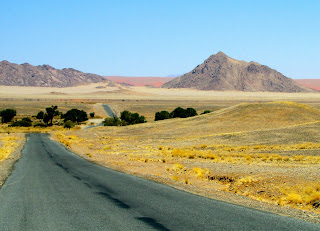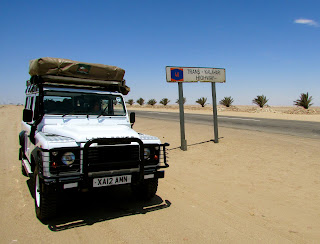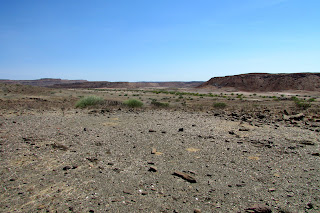For the past few weeks, we have been traveling through a very dry and hot climate, skirting the edges of several desert areas. Our final leg to the end of the trip in Windhoek had us travelling to and through portions of the oldest desert in the world -- the Namib.
From Walvis Bay, its a long dry sand road across the dunes towards the small settlement of Solitaire. Solitaire is the only place to get gas or anything else in that part of the country, and supposedly has an amazing bakery which was closed when we stopped. The temperature was already over 100 degrees as we continued south towards Sesriem, the gateway to the Namib Desert. And there, in the middle of nowhere, we crossed the Tropic of Capricorn.
Arriving at Sesriem mid afternoon, we checked in at the ranger's office and started the drive towards Sossuslevi, a 70 km drive from the campground. We had been advised that the best time to view the dunes was at dawn or dusk to capture the sun's low angle light so we hoped to time it to see it late afternoon.
 |
| Sesriem Gate |
While I didn't have a thermometer handy, we guessed the heat at this point was closer to 110 degrees. At the end of the paved road, we stopped in a shady rest area to have lunch before tackling the sand road to the dunes. This being Africa, there really wasn't a designated track through the sand so we followed previous travelers. And quickly became stuck -- up to the frame.
We had been equipped with a shovel so I started digging out the wheels and frame. Several attempts to move proved futile so I kept digging. I lowered the air pressure in the tires which often works but still no luck. Just then, a Toyota pickup arrives driven by a very nice French couple. Using hand signals and broken English, we managed to rig a tow rope and Oswald came free.
We only had to travel a bit more to find an area where we could park and take a short hike on the dunes. In addition to being the oldest desert in the world, the Namib contains what is arguably the tallest sand dune in the world.
It was still hot and I was pretty spent from shoveling but we did manage to hike a good way up it. On the way back to camp, the sun was dropping quickly and the light created amazing shadows on the dunes.
The campground was fairly busy and noisy but we cooked a nice dinner and turned in early. The light at sunrise was spectacular.
From Sesriem, we started the drive back to Windhoek, Namibia's capital and the end of our trip. We spent one night in a nice secluded camp near Rehoboth which afforded us the opportunity to wash clothes and pack our gear for the journey home. A pack of baboons in the hills above entertained us until we fell asleep.
Arriving in Windhoek after driving incredibly remote country for three weeks was a bit of a let down. All the traffic and people created quite a case of sensory overload. After cleaning up, we headed to Joe's Beer House, a place that had been recommended by just about anyone who knew we were headed to Windhoek. It's a pretty interesting place and in addition to a great beer selection, they apparently serve a LOT of Jagermeister.
 |
| The Mini was used by some Europeans in an unsuccessful attempt to drive the length of Africa. |
We drove almost 2400 miles in just over three weeks through some of the most beautiful country anywhere. We got stuck once, almost hit a Zebra, saw many animals and met some wonderful people. It is often said that Africa gets under your skin and it certainly has mine. Future trips back are currently being dreamed about, and hopefully my daughter and her family will join us.
Thanks for following along. If anyone wants more pictures or information about places we've stayed and sights we've seen, you know where to find us.


























































































